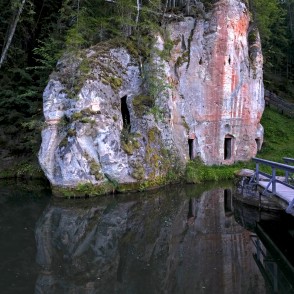These are 17 m high, beautiful reddish cliffs. There are several rectangular holes in the foot – these were cellars which were abandoned long ago. The lower part of the Rock like a narrow cliffy chain lies over waters – about 4 meters higher there is a hole – cellar.
Cliffs can be also seen on Rigaskalns and behind it. It is characteristic that cellars used for storage of wine and different food have preserved in cliffs. A historical value of these cellars is immeasurable. They are a geological and geomorphological natural monument.
At Anfabrika cliffs a floodgate “divides” the Ligatne River into two separate rivers – one, the task of which is to flow into Gauja and provide excellent places for spawning of salmon and taimen, and another, the task of which is to supply Ligatne Paper Mill with very fresh paper production raw material – water. Namely clear waters, fast stream of Ligatne River and surface pattern of Ligatne encouraged merchants from Riga Konrad Just Stroh and Karl Kiber to conclude agreements about renting of water mills and surrounding lands of Paltmale Estate in 1814 to start construction of a paper workhouse.
In addition to stories about cliffs, caves and cellars on the territory of Anfabrika cliffs you can get acquainted with engineering and technical achievements of the 19th century. Here there are supports of an aqueduct (the aqueduct is on the picture below), which served less than two hundred years ago to supply water from old floodgate for the needs of Anfabrika (Handfabrik). Here you can see the system of floodgates and channels which have been worked till nowadays to supply the Paper Mill with necessary water resources for paper production. And, of course … cliffs and cellars.
www.visitligatne.lv








